|
by Rumen Ivanov . Durostorum
lies at the modern town of Silistra, in the northeastern tip of
Bulgaria (figs.2,3). The eastern outskirts of Silistra lie on the
Danube river, forming the border between Bulgaria and Romania. Here the
Danube forms an elbow and flows northeast toward the Black Sea.
Underlying the modern settlement is Roman Durostorum, called Durostero on the Peutinger Table (fig.1), and later called
Drastar during the Middle Ages. In addition to its function as an
important Roman military center, Durostorum was also a significant
river harbor, road junction, and customs station in the province of
Lower Moesia. During the period of late antiquity, Durostorum lay
within the province Moesia Secunda, created by Diocletian betw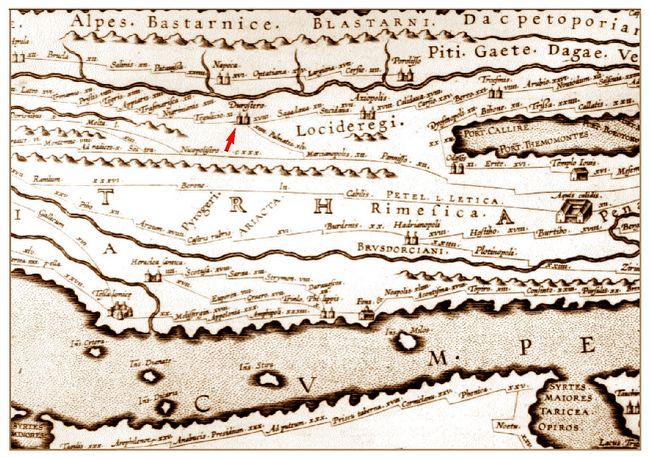 een AD
286 and 293. een AD
286 and 293. Fig 1: A section of the Peutinger Table. Durostorum (arrow) is shown as “Durostero” (photo: R. Ivanov).
Early site history:
Durostorum and its surrounding areas were inhabited by Getic tribes,
Getae being a collective name used by ancient writers to designate
northern Thracian tribes in the northeast Balkan Peninsula, on both
sides of the lower Danube. Until now, there have been no systematic
archaeological investigations of the Thracian settlement underlying
Roman Durostorum. Its presence is indicated by occasional finds around
Silistra (fig.2), dating to the 1st millennium BC. These are kept now in the
town’s Museum of Archaeology and in private collections from Bulgaria
and Romania. Recovered articles include a bronze fibula from the 9th
century BC; a gray-black Thracian ceramic cup typical of the Early Iron
Age; a metal candlestick from the Late Iron Age, a hoard of
t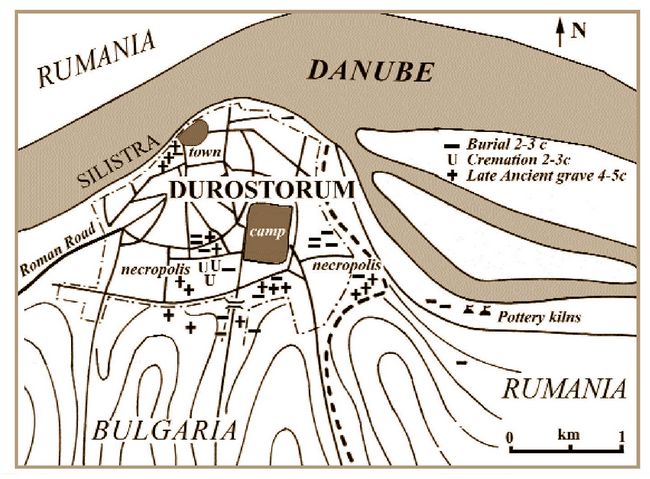 hirteen
4th century drachmae minted in Histria on the western Black Sea coast;
three amphorae from the first half of the 4th century BC imported from
Heraclea Pontica; a gold earring; and a 3rd century BC gold pin
decorated with small pearls placed in gold sockets. hirteen
4th century drachmae minted in Histria on the western Black Sea coast;
three amphorae from the first half of the 4th century BC imported from
Heraclea Pontica; a gold earring; and a 3rd century BC gold pin
decorated with small pearls placed in gold sockets. Fig.2: Durostorum at the site of modern Silistra. Details of 2nd-5th c AD necropoli are in key (after P. Donevski 1990).
The
Roman era: During the reigns of Claudius (AD 41-54) and Nero (AD
54-68), the eastern border of the Roman province of Moesia (founded in
AD 12) extended to the mouth of the river Iatrus (the modern Yantra).
However, the Empire’s military control stretched along the Danube
beyond the provincial border. Durostorum was one of several important
river points already in Roman possession at that time.
The
first Roman military garrison at Durostorum was most probably composed
of an auxiliary unit. The systematic construction of the military road
along the right (southern) Danube bank had already begun to move
downstream from Singidunum (Belgrade) by Tiberius’ reign (AD 14-37).
The road section from the mouth of the Iatrus river to the Danube delta
was finished under the Flavian emperors (AD 69-96). A side road
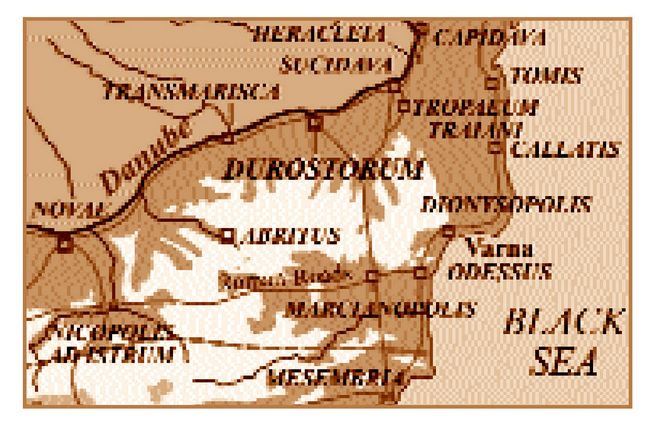 branched off at Durostorum and led to Marcianopolis and further
towards the south (fig.3). After the Dacian Wars of emperor Trajan in
AD 101-102 and 105-106, Durostorum was garrisoned by the legio XI
Claudia. Detachments of that legion are epigraphically recorded in
Montana in AD 136, as well as in the northern zone of the Black Sea. branched off at Durostorum and led to Marcianopolis and further
towards the south (fig.3). After the Dacian Wars of emperor Trajan in
AD 101-102 and 105-106, Durostorum was garrisoned by the legio XI
Claudia. Detachments of that legion are epigraphically recorded in
Montana in AD 136, as well as in the northern zone of the Black Sea. Fig.3: Map of Northeast Bulgaria, showing Roman sites. Durostorum
and its vicinity were strongly affected by an invasion of the Costoboci
in AD 170. The area was again hit hard by barbarian incursions during
the reign of Gordian III (AD 238-244), when the lower Danubian
provinces were several times overrun by Carps, Goths and Sarmatae. One
somber inscription from Durostorum dating to AD 238 tells of a person
who had to be ransomed from the barbarians. Reflecting insecurities of
the times, small hoards of coins, ending with the period of Gordian
III, were found even in the territory of the legionary camp.
The
great Gothic invasion of AD 250-251 brought about new troubles for
Durostorum. After the Roman army was overwhelmed in AD 251 at the
battle of Abritus (pp.49-54), in which the emperor Trajan Decius
perished, the victorious Goths ravaged adjacent regions of Lower Moesia
and retreated north of the Danube, crossing the river somewhere in the
section called Sexaginta Prista (modern Rousse).
A
fragmentary building inscription from Durostorum, dated to AD 272-273,
confirms the occurrence of a Carpic raid into Lower Moesia during the
reign of Aurelian (AD 270-275). The text tells of the victorious
campaigns of Aurelian against Zenobia, queen of Palmyra and the Carps.
“[quot] imperator Aurelianus vicit [reginam Ze]nobiam inviso[sque tyrannos et Carpos inter... Ca]rsium et Sucid[avam delevit.]”
It
also explicitly states that the Carps were defeated in a battle in the
frontier zone east of Durostorum, between Carsium and Sucidava. Many
Lower Moesian officials of high status are epigraphically documented in
Durostorum. One of these officers was Domitius Antigonu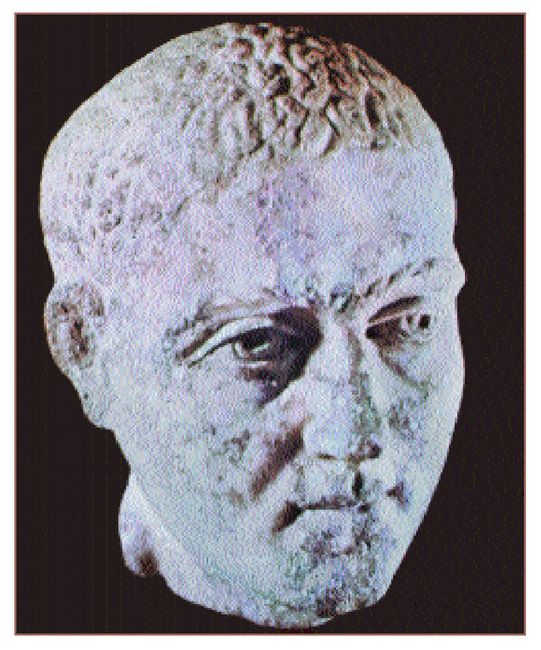 s, governor of
Lower Moesia in AD 235-236. The inscription reads: s, governor of
Lower Moesia in AD 235-236. The inscription reads:
“Divinib[us]
Romae aeternae, Ge[ni]o provinciae Moes(iae) Inf(erioris) Dom(itius)
Antigonus, v(ir) c(larissimus), leg(atus) Aug(usti) pr(o) pr(aetore)
cum Pompeia Apa, c(larissima) f(emina), coniuge et Domitiis Antigon(us)
et Ant(igonus).”
This
invocation to Roma aeterna and the provincial Genius of Lower Moesia
was made by the whole family - the governor himself, his wife Pompeia
Apa, and both sons. Fig.4: Marble head of a man from Durostorum, beginning of the 3rd century AD (photo: S. Roussev; Silistra Historical Museum, archives).
A
dedication to Jupiter has been recovered from the third quarter of the
3rd century AD set up for the health and well-being of Aurelius Dizzo,
another notable man whose name suggests Thracian origin:
“I(ovi)
O(ptimo) M(aximo) Sacrum. Aur(elius) Dizzo, v(ir) p(erfectissimus),
praes(es) prov(inciae), pro salute sua, suorumque omnium v(otum)
l(ibens) p(osuit).”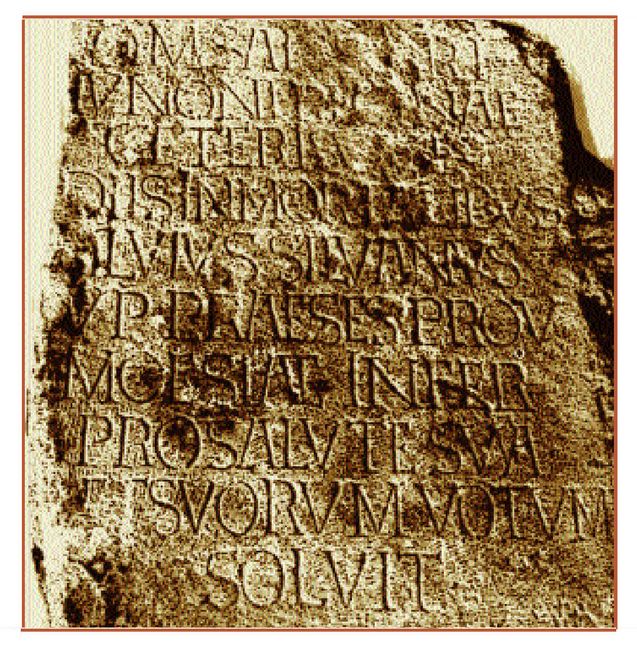 Jupiter,
Juno, and other Roman deities are honored in a similar, nearly
contemporary monument from the late 3rd century, set up for the
well-being of Silvius Silvanus:
"I(ovi)
O(ptimo) M(aximo) Sal[uta]ri, Iunoni Reginae ceterisque Diis
inmortalibus [S]ilvius Silvanus, v(ir) p(erfectissimus), praeses
prov(inciae), pro salute sua et suorum votum solvit.” (fig.5).
Fig.5: Dedicatory inscription of Silvius Silvanus (P.Donevski 1976).
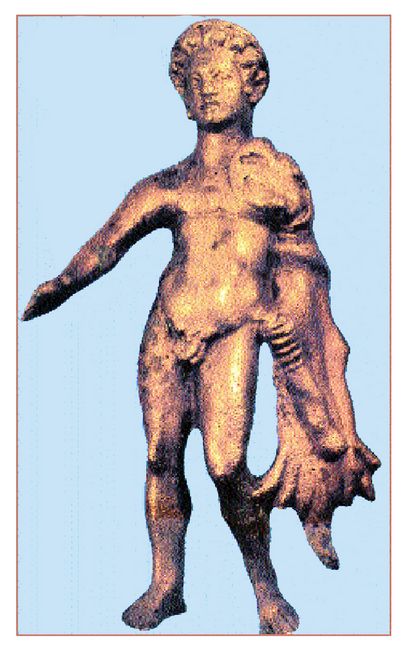 As
in each important military center, individuals from all parts of the
Empire could be encountered in Durostorum. Finds of inscriptions,
votive tablets and other sculptured monuments dating from the 2nd and
3rd centuries AD show worship in a number of religious cults including
those to the deities Jupiter, Juno, Hercules (fig.6), Mithras, and
Dolichenus. The high popularity of the Thracian Horseman deity points
to a considerable indigenous population in Durostorum. Saturn was also
esteemed, and special feasts in his honor (Saturnalia) were organized
yearly. Among a several examples of Roman portrait sculpture known
from Durostorum is a life-size marble head of a man dating from the 3rd
century AD (fig.4). As
in each important military center, individuals from all parts of the
Empire could be encountered in Durostorum. Finds of inscriptions,
votive tablets and other sculptured monuments dating from the 2nd and
3rd centuries AD show worship in a number of religious cults including
those to the deities Jupiter, Juno, Hercules (fig.6), Mithras, and
Dolichenus. The high popularity of the Thracian Horseman deity points
to a considerable indigenous population in Durostorum. Saturn was also
esteemed, and special feasts in his honor (Saturnalia) were organized
yearly. Among a several examples of Roman portrait sculpture known
from Durostorum is a life-size marble head of a man dating from the 3rd
century AD (fig.4).
Fig.6: Bronze statuette of Hercules from the early 3rd century AD (Silistra Historical Museum, archives).
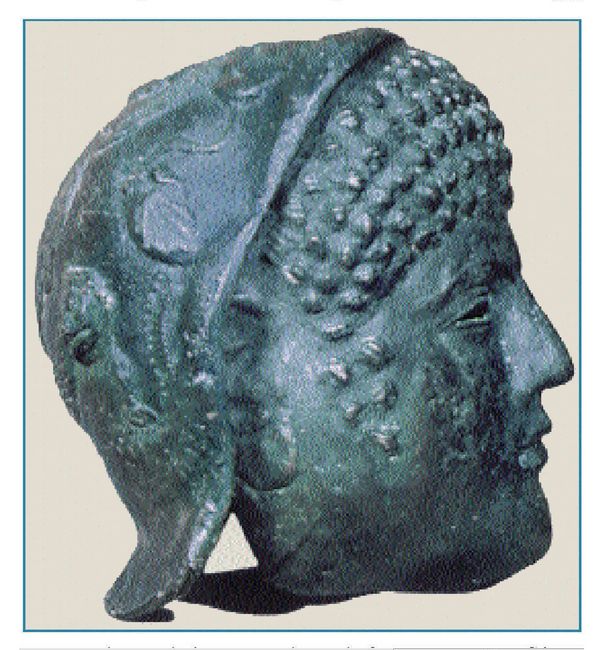
A
bronze Roman parade mask (fig.7) and a standard soldier's helmet were
both found within the town limits of Silistra (now at the Museum of
Archaeology). Another striking example of a cavalry parade helmet
(fig.8) was added to the museum in 1984. Unfortunately missing is the
front mask of this piece, which was also used in athletic competitions.
Its surface is richly decorated with representations of Sol Invictus,
Athena and another deity (perhaps Mars). Discovered on a bank of the
Danube near the ancient settlement named Tegulicium (west of
Durostorum), the helmet is dated to the 2nd or 3rd quarter of the 3rd
century. Fig.7: A bronze legionary parade mask from Durostorum (Silistra Historical Museum, archives). 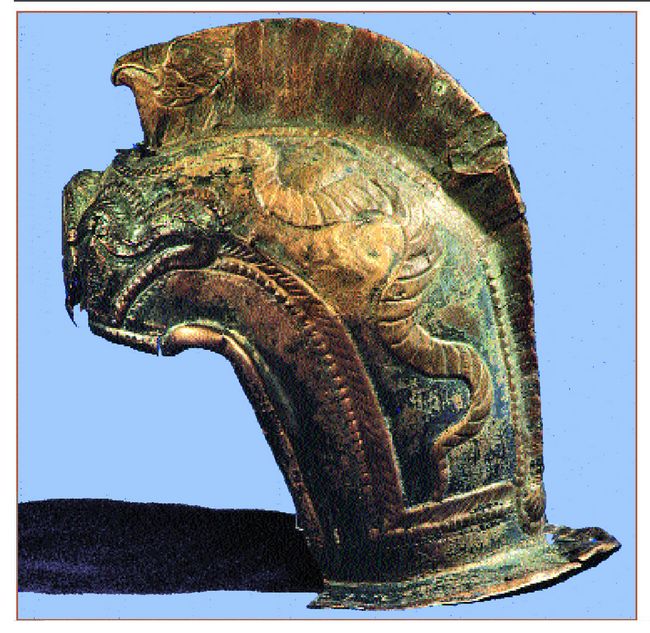
Durostorum
was twice visited by the emperor Diocletian (AD 284-305) during his
inspection of the lower Danube frontier or limes on October 21-22, AD
294 and once again on June 8, 303. The emperor Valens (364-378) also
stayed in Durostorum for a significant amount of time during the First
Gothic War of 366-369. The Visigoths, granted the status of Roman
foederates in AD 376, settled in Thrace, then crossed the Danube under
pressure from the Huns, and entered the Empire in great numbers near
Durostorum (one of the catalysts for the eventual collapse of the
Empire in the early 5th century AD).
Fig.8: A 3rd c. AD bronze cavalry helmet from Tegulicium (photo: G. Atanasov; Silistra Historical Museum, archives). The
city is also the birthplace of the famous late Roman military commander
Flavius Aetius, who is perhaps best known for defeating Attila the Hun.
According to Gothic historian Jordanes, Aetius “descended from the
people of the extremely brave Moesians” (Getica, 176). Aetius commanded
the united forces of the Roman Empire and its Frankish, Burgundian,and
Visigothic allies against the Huns who, led by Attila, invaded the
Empire in the middle of the 5th century. The decisive battle took place
in July of AD 451 at the Catalaunian Fields in northern France, ending
with the utter defeat of Attila. However, the glory and increasing
prestige of Aetius frightened emperor Valentinian III (AD 424-455), and
he ordered the general’s murder on September 21, AD 454.
Durostorum
was an important center of early Christianity, which had spread
considerably by the latter part of the 3rd century. In the 4th century
the bishopric of Durostorum was held for many years by Auxentius, a
disciple of the Gothic bishop Ulfila. The latter, who translated the
Bible into the Gothic language, was the leader of the so called Gothi
minores. These Arrian Christians in AD 348 were granted permission to
settle in the Roman Empire in the region of Nicopolis ad Istrum, near
the modern village of Nikyup in the Veliko Tarnovo district (fig.3).
The famous Christian martyr Dasius was born in Durostorum, where his
relics were kept until the late 6th century when they were transported
to Ancona in Italy, where they are still preserved in the cathedral of
St. Cyriacus.
Barbarian
foederates of different ethnicity were included among the population of
Durostorum in late antiquity. Also present from the 4th century onward
were Goths, and, in the 6th century, Slavs. The city was repeatedly
attacked and plundered by Avars and Slavs in the end of the 6th through
the 7th centuries AD. Immediately after the establishment of the
Bulgarian Kingdom on the Lower Danube in AD 681, Durostorum (renamed
Drastar) became one of its most important strategic strongholds.
Archaeology
of the legionary camp: The remains of Roman Durostorum lay just beneath
the central portion of modern-day Silistra, mak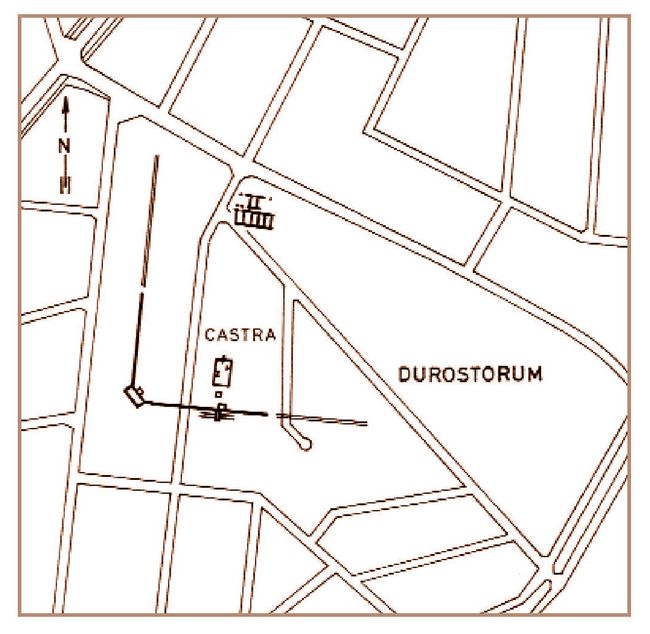 ing it especially
difficult to carry out archaeological excavations at the site.
Investigations led by P. Donevski from 1972 to 1981 succeeded in
locating and partially revealing the layout of the ancient legionary
camp, or castra (figs.2,9). Situated 1 km south of the Danube bank with
fortified areas amounting to 17.3 ha, the camp had a rectangular plan
with rounded corners, and measured roughly 480 m (N-S) by 360 m (E-W). ing it especially
difficult to carry out archaeological excavations at the site.
Investigations led by P. Donevski from 1972 to 1981 succeeded in
locating and partially revealing the layout of the ancient legionary
camp, or castra (figs.2,9). Situated 1 km south of the Danube bank with
fortified areas amounting to 17.3 ha, the camp had a rectangular plan
with rounded corners, and measured roughly 480 m (N-S) by 360 m (E-W).
Fig.9: Durostorum’s military camp or castra set amid the street plan of modern Silistrum (after P. Donevski 1995).
While
relatively little information is available on the earliest building
phase, the fortification system has been studied in several areas.
Initially the wall was about 1.50 m thick and was reinforced with inner
rectangular towers. One such tower measuring 6.4 by 3.4 m has been
excavated on the southern precinct wall, west of the supposed main
gate, or porta decumana. Its foundations are entirely built in opus
caementicium (masonry work), while the superstructure, with only two to
three surviving rows, is faced with small stone blocks on both sides
(opus vittatum). 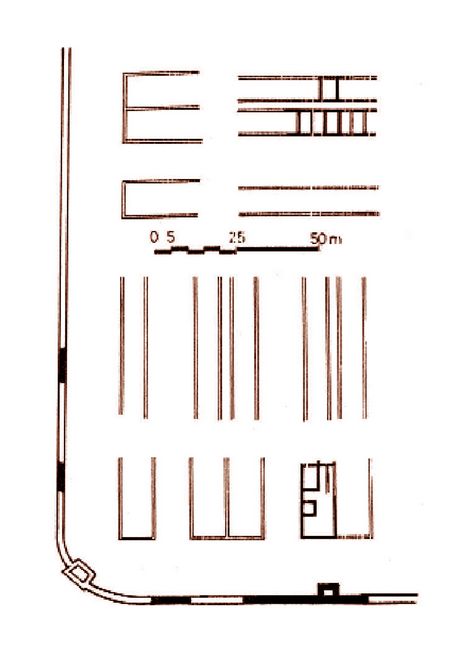
Other
defensive works in the camp’s perimeter include the tower in the
southwest corner, also excavated. Situated 69 m west of the southern
precinct tower just mentioned, it is trapezoidal in plan (9.4 by 7.95
m).While generally dated to the first half of the 2nd century AD, some
of these defenses may actually originate from the time of Trajan who,
in AD 106, transformed Durostorum into a legionary base and stationed
the legio XI Claudia there after the end of the Second Dacian War. Fig.10: Southwest corner of the legionary camp, with barracks at north (after P. Donevski 1995).
Among
the few buildings excavated within the camp is a structure 17 m north
of the southern wall, of which 260 m2 have been uncovered. It consists
of two rows of rooms placed on either side of a central corridor. Only
one chamber (4.45 by 3.95 m) in the western part of the building has
been entirely preserved. The structure is thought to have been a
centurion’s dwelling. Presuming that his centuria lay nearby,
archaeologists have found remains of two barracks 150 m north of the
southern precinct wall (fig.10). Both have an east-west orientation and
measure 8.5 m wide. The barracks consist of many rooms of similar size,
measuring 3.8 by 4.4 m, only six of which have been entirely excavated.
The
legionary camp at Durostorum was reconstructed in the late 3rd century
during the reign of either Aurelian or Diocletian. A new type of mortar
was used for this building project - pink in color, containing a
mixture of small tile and brick pieces. The thickness of the precinct
wall was increased to 2.6 m and a large new tower appeared at the
south-west corner. The latter tower of rectangular plan projected
slightly outwards and measures 21.7 by 12.8 m (fig.10).
The
canabae: A dedication to Jupiter found in Silistra and dated to AD 145
(CIL III 7474) reads that two wealthy citizens set up a statue on
behalf of the cives Romani et consistentes in canabis Aeliis. This
inscription unequivocally proves that a canabae, or veterans’
settlement around the castra, was already established in Durostorum by
the time of Hadrian’s reign (AD 117-138). The canabae were situated
north, west, and northwest of the legionary camp, covering 60 to 75
acres (fig.2).
Up
to the present, several buildings hav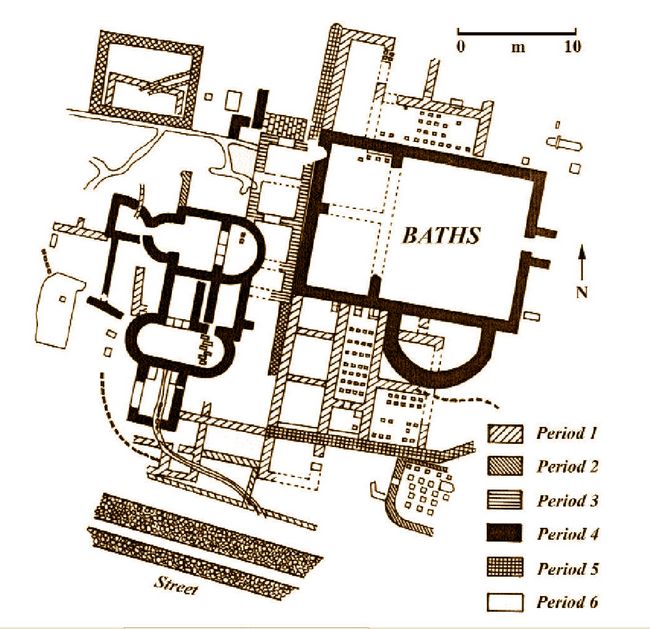 e been partially excavated in the
territory of the canabae, one being a public bath located some 250 m
north of the camp. Built in the first half of the 2nd century, it had a
continuous plan of linked buildings facing southwest (fig.11). Bathers
were provided with three pools for warm water and one pool (piscina)
containing cold water. During the following centuries, the bath
underwent several major reconstructions, with the latest repairs dating
to the middle of the 4th century AD. e been partially excavated in the
territory of the canabae, one being a public bath located some 250 m
north of the camp. Built in the first half of the 2nd century, it had a
continuous plan of linked buildings facing southwest (fig.11). Bathers
were provided with three pools for warm water and one pool (piscina)
containing cold water. During the following centuries, the bath
underwent several major reconstructions, with the latest repairs dating
to the middle of the 4th century AD. Fig.11:
Baths in the canabae at Durostorum, and residential buildings to the
south. Six periods of construction are indicated between the 2nd and
4th centuries AD (after P. Donevski 1990).
During
recent excavations of the baths, floor bricks stamped with the name
RVMORIDVS were found in one room. This refers to Flavius Rumoridus, who
because of his contributions to the general reconstruction and
refortification of the province in the 4th century, is thought to have
been dux provinciae Moesiae Secundae. In AD 384 he was promoted to the
rank of magister militum, and in AD 403, towards the end of his career,
he was appointed consul of Constantinople.
In
addition to the public bath, a large private building to the southwest
has been discovered dating to the mid-2nd century AD. Rooms in the
northern and southern ends of the structure were insulated for heating
by hypocaust or underground furnace with wall ducts. In the beginning
of the 3rd century a small bath composed of a row of rooms, each
supplied with a hypocaust, was built against the western wall of this
building. All structures were dismantled a century later, and on top of
the ruins newer and larger buildings were constructed with exedrae or
semicircular porticoes in the southeast ends. A sun-dial dating from
the beginning of the 3rd century was also found in situ some 120 m
north of the structures with hypocausts just described. Detailed
analyses suggest the central square of the canabae of Durostorum may
have been located at this very place.
Durostorum
as a municipium: The administrative status of Durostorum was elevated
to that of a municipium in the late 2nd or early 3rd century AD. Key
evidence for this comes from the village of Ostrov, Rumania, some 4 km
east of Silistra. Numerous significant finds at this site prove the
existence in Roman times of a large vicus, or native Thracian town. One
Latin inscription engraved on a block of stone and reused as building
material in a late antique structure had a dedication to Jupiter and
Juno for the health of the emperor Marcus Aurelius 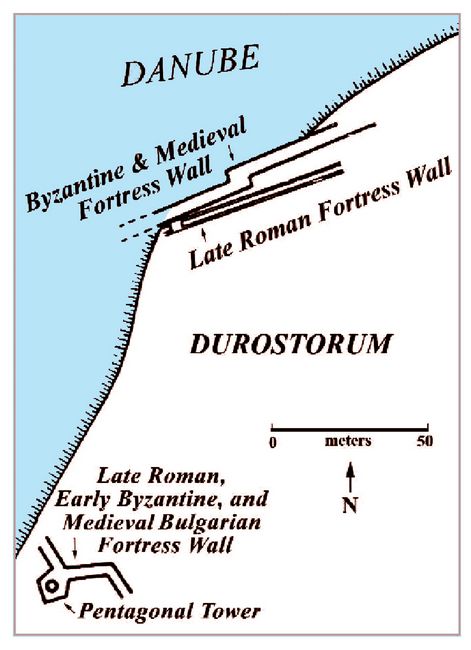 Antoninus, and the
municipium Aurelium Durostorum. It mentions six dedicators, all members
of Durostorum’s city administration. Antoninus, and the
municipium Aurelium Durostorum. It mentions six dedicators, all members
of Durostorum’s city administration.
While
some scholars suggest that Durostorum was granted a municipal status
during the reign of Marcus Aurelius (AD 161-180), others consider the
emperor named in the text to be M. Aurelius Antoninus Caracalla (AD
211-217). Another unresolved question concerns which of the two civic
settlements in the vicinity of Durostorum, the canabae or the vicus,
was elevated in rank to municipium, or self-governing city.
Fig.12: The excavated area on the Danube bank (after S. Angelova 1973).
Excavations
on the Danube bank in Silistra led by S. Angelova from 1969 to 1971
resulted in the discovery of late Roman, Byzantine, and medieval
fortifications (fig.12). A 55 m section of circuit wall was unearthed,
with the equivalent of two rows’ height preserved. The late Roman wall,
2.3 to 2.6 m thick, was built of rectangular stone blocks cemented with
pink mortar on both faces. The fortification may be identified with the
newly built praesidium or headquarters building mentioned in a
legionary inscription from Silistra, dated to AD 298-299. Similar
inscriptions from the same period are also known from Sexaginta Prista
(Rousse) and Transmarisca (Tutrakan), the latter dismantled and
rebuilt during the reign of Justinian I (AD 527-565). A pentagonal
tower from this fortification has also been excavated (fig.12). By this
time, the garrison of late ancient Durostorum is thought to have been
stationed in new fortifications on the Danube bank, to the southwest of
the earlier fortress walls.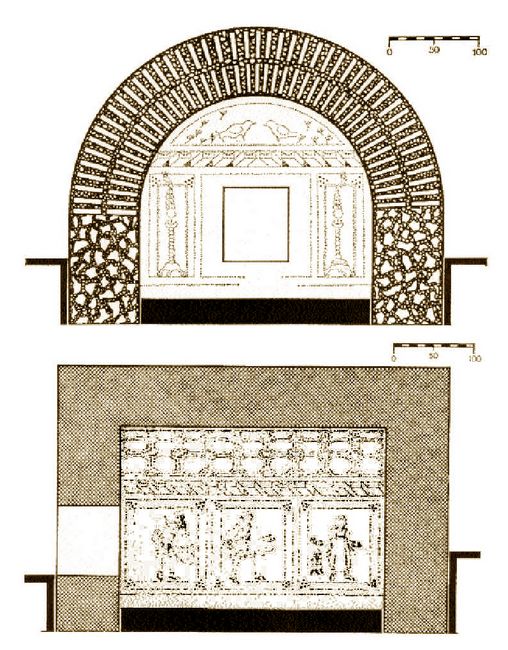 Constructions
dating from the 5th to 6th centuries AD have also been discovered
within the walls of the old legionary fortress, whose territory was
probably settled by a civilian population in late antiquity.
Interestingly, written accounts by the empress Anna Comnena (AD
1083-1148) indicate two fortresses in Durostorum were still standing at
the beginning of the 11th century.
Grave
Finds from Durostorum: Several necropoli located around Roman
Durostorum include both cremation urns and extended burials (fig.2).
One necropolis is 2 km east of the central portion of Silistra, and
another, dating to late antiquity with some Christian interrments, is
situated on the southeastern edge of the modern town. Fig.13: Cross-section of the Silistra tomb (Silistra Historical Museum, archives). The
Silistra Tomb: In 1942 a late Roman tomb containing well-preserved wall
paintings was accidentally discovered southeast of the town center in
Silistra, at a depth of only 0.7 m beneath ground level. The tomb is a
single-chambered vaulted building with a rectangular plan of 3.3 by 2.6
m, with a maximum height of 2.3 m (fig.13). The tomb’s stone walls (0.6
m thick) are joined by reddish-white mortar, while the vault, composed
of two rows of mortered brick, begins from a height of 1 m. The floor
is paved with bricks, with the entrance on the east side of the
building. In 1964 preservation efforts began on the tomb, which is
surrounded with a special protective coat to shield it from damaging
conditions.
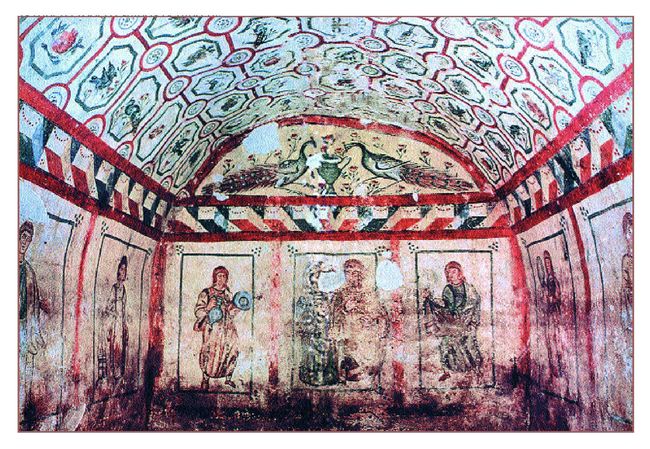 The
tomb is decorated with polychrome wall paintings divided into upper and
lower registers or pictorial zones, on the vault and on the walls
themselves (fig.14). The subject matter of these paintings is the representation
of heavenly paradise and the beauty of the next world. Juxtaposed is a
lower band of paintings illustrating mortal existence, according to a
tradition established in the Hellenistic period. Fig.14: The west half of the tomb at Silistra (photo: K. Tanche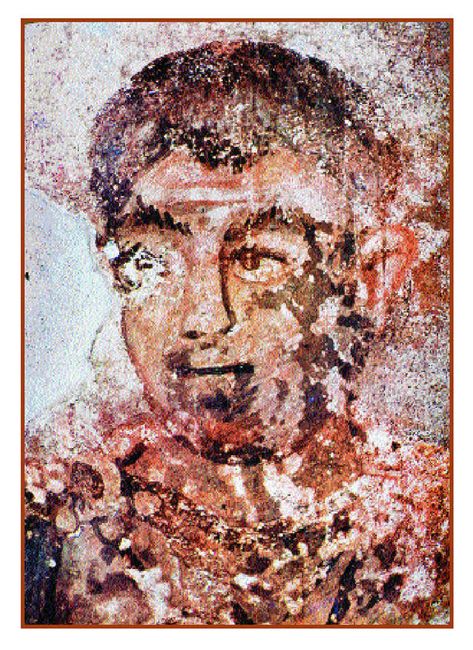 v; Silistra Historical Museum, archives). v; Silistra Historical Museum, archives). Each
of the walls, with the exception of the eastern one, is divided into
three separate rectangular pictorial fields. On the west wall, a couple
is depicted on the central plane (fig.14). The man, with closely
cropped hair and a coarse face, is dressed in a tunic and mantle and
holds a scroll in his hand, possibly a marriage settlement (fig.15). Fig.15: The face of the deceased master, west wall of tomb (Silistra Historical Museum, archives).
His
wife (whose head is much eroded) stands behind him, dressed in a
long-sleeved tunic with a kerchief on her head. While her left hand
rests on her husband’s shoulde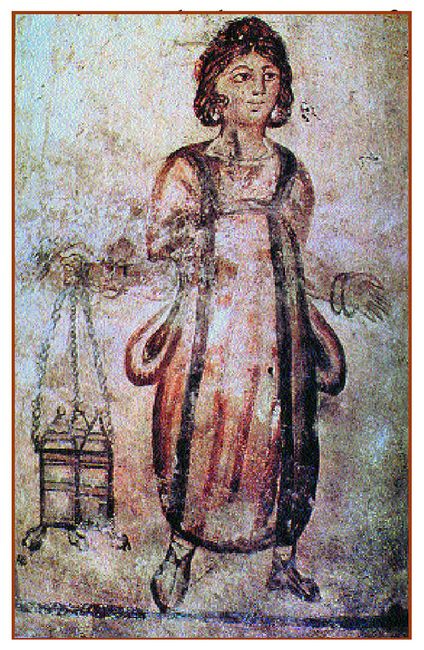 r, she holds a rose in her right hand. r, she holds a rose in her right hand. In
north and south panels, male and female servants approach their masters
carrying garment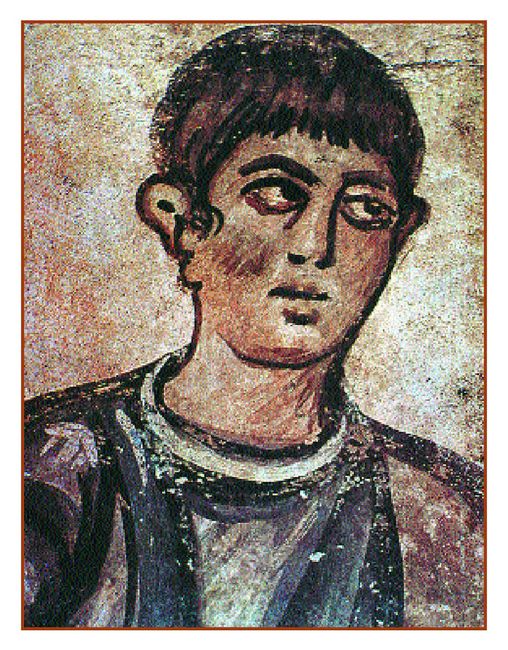 s and toiletries (figs.16-18). Among the men are Goths,
as well as representatives of other nations. s and toiletries (figs.16-18). Among the men are Goths,
as well as representatives of other nations.
Fig.16 (left): Female servant from south wall (Silistra Historical Museum, archives).
Fig.17 (right): Male servant, middle field on north wall (Silistra Historical Museum, archives).
The
eastern wall has two fields with funeral torches represented on either
side of the entrance. Painted bands of trim separate the lower
pictorial band from the vault. Two birds, perhaps pigeons, with ribbons
in their beaks are represented on the eastern lunette, balancing two
peacocks on the west wall on either side of a bronze vessel
(cantharos). The decoration of the vault imitates a casette, or paneled
ceiling, whose fields contain 63 smaller paintings of vegetation and
animal motifs, as well as hunting scenes.
There
are two somewhat differing views on the dating of the late antique
Silistra tomb. D. P. Dimitrov and M. Chichikova date the structure to
the last quarter of the 4th century. Based on the style of mural
painting, however, Drs. V. Popova and J. Valeva prefer an earlier date
in the fourth or fifth decade of the 4th century. Ev en
from a purely
historical point of view, the latter time period seems the more
likelyof the two. It is difficult to believe that such an elaborate example
of tomb architecture would have appeared after the disastrous Gothic
invasion of AD 376-378, an event which severely ravaged the region and
ushered in years of disorder and economic collapse. en
from a purely
historical point of view, the latter time period seems the more
likelyof the two. It is difficult to believe that such an elaborate example
of tomb architecture would have appeared after the disastrous Gothic
invasion of AD 376-378, an event which severely ravaged the region and
ushered in years of disorder and economic collapse.
Fig.18: Servant on the south wall (Silistra Historical Museum, archives).
Chariot
Burial of a High-Ranking Aristocrat: In autumn of 1968, during excavations in the southeast necropolis of Durostorum not far from the
Silistra tomb, the burial site of a high-ranking aristocrat was
accidentally discovered in Silistra (compare also the elaborate 2nd
century AD chariot burial more recently discovered at Tran, p.31.) At
Silistra, the deceased man had been buried in a wooden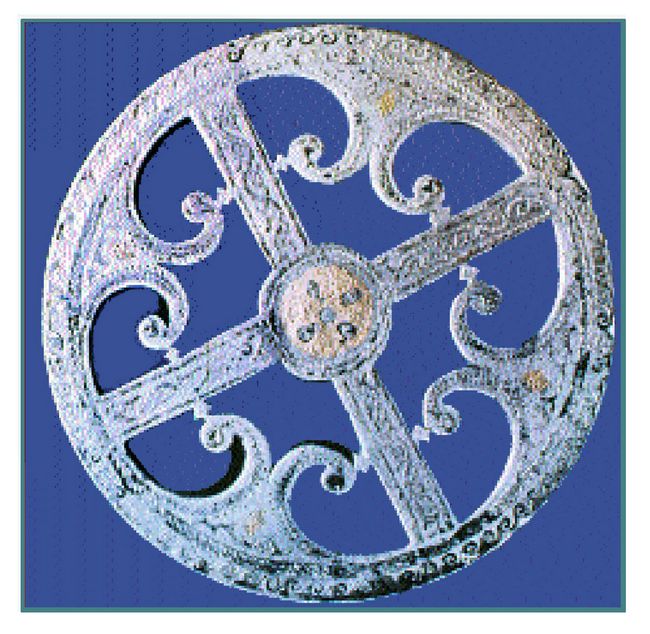 coffin whose
interior was lined with lead plates. Grave goods found with the
physical remains include a gold fibula (fig.21), two iron swords in
wooden sheaths (fig.22), four iron spear heads, a suite of silver belt
appliques (fig.19), a massive gold ring with a gem depicting the
goddess Fortuna (fig.20), and a coin of the emperor Probus (AD
276-282). coffin whose
interior was lined with lead plates. Grave goods found with the
physical remains include a gold fibula (fig.21), two iron swords in
wooden sheaths (fig.22), four iron spear heads, a suite of silver belt
appliques (fig.19), a massive gold ring with a gem depicting the
goddess Fortuna (fig.20), and a coin of the emperor Probus (AD
276-282). Fig.19: Openwork disk from a cross-belt, of silver, gold,and precious stones (Silistra Historical Museum).  The
fibula (fig.21) is an early version of bulb-headed types whic The
fibula (fig.21) is an early version of bulb-headed types whic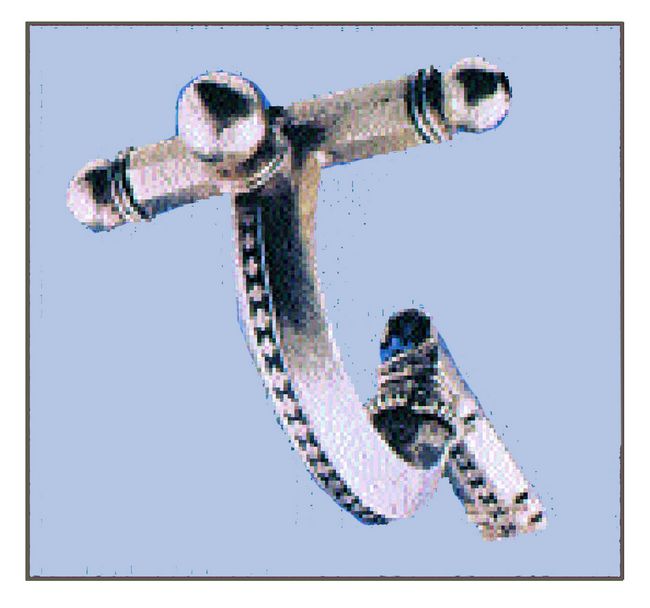 h first
appeared in Moesia and Thrace soon after the middle of the 3rd century
and became very popular during the reign of Constantine the Great (AD
306-337). h first
appeared in Moesia and Thrace soon after the middle of the 3rd century
and became very popular during the reign of Constantine the Great (AD
306-337).
Fig.20 (left): Gold ring with gem and Fortuna emblem. Fig.21 (right): A gold bulb-headed fibula (Silistra Historical Museum, archives). The sheaths of both swords (fig.22)form large silver discs on their
ends, and the handle of one of the swords is made of silver and ends
with an elliptical plate studded with semi-precious stones. The sheath
of the same sword is completely encased in silver and features on its
exterior gilded plates encrusted with rubies and other precious gems.
The silver appliques are finely detailed with inlaid engraving (the
“nielle” technique popular in antiquity). The le ather belt holding
these swords has not been preserved. The identical style of decoration
of the two swords and the silver belt appliques appear to prove that
both were made to order simultaneously in one workshop. ather belt holding
these swords has not been preserved. The identical style of decoration
of the two swords and the silver belt appliques appear to prove that
both were made to order simultaneously in one workshop.
Fig.22: Swords and scabbards from chariot burial (photo:P.Franz;Silistra Historical Museum, archives)
Just
next to the coffin were found the remains of a four-wheeled chariot
buried during the funeral ceremony, together with the four horses
harnessed to it (see also p. 31). The chariot was richly decorated with
numerous bronze appliques and statuettes depicting gods, mythological
creatures, and 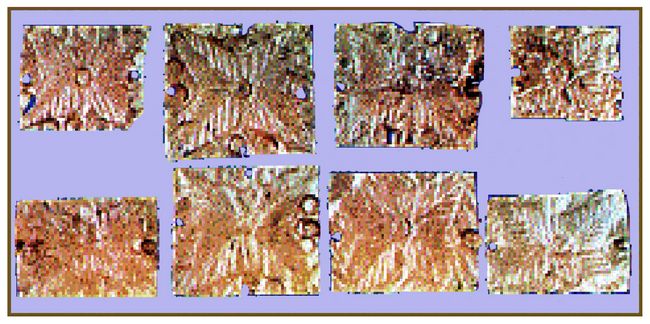 animals including Dionysos, satyrs, and a panther. The
harness was also decorated with gold lamellae or layers (fig.23).
Compared to the craftsmanship of the swords and belt appliques, the
decorated articles from the chariot are of an inferior quality,
characteristic of the mass production of local provincial workshops. animals including Dionysos, satyrs, and a panther. The
harness was also decorated with gold lamellae or layers (fig.23).
Compared to the craftsmanship of the swords and belt appliques, the
decorated articles from the chariot are of an inferior quality,
characteristic of the mass production of local provincial workshops. Fig.23: Gold appliques from harness (photo: P. Franz; Silistra Historical Museum, archives).
The chariot burial site most certainly dates to the end of the 3rd century
AD. Its unique nature is emphasized by the magnificent set of two
swords produced in a first-rate imperial atelier. The grave goods leave
little doubt that the deceased belonged to the local provincial
aristocracy, and was either a superior military commander or
high-ranking state official.
References: Ancient Sources on Durostorum
2nd
and 3rd centuries AD: Claudius Ptolemaeus (ca. AD 83-161), noting the
settlement Dourostoron in his work Geographia (III, 10, 5), provides
the earliest listing of the site. The Peutinger Table (fig.1) shows a
station called Durostero on the road from Singidunum (Belgrade) to the
Danube delta. Dorostoro is also in the 3rd century AD Antonine
Itinerary (223, 4), as both a road station and military base for the
legio XI Claudia. In AD 294, an edict of the emperors Diocletian and
Maximianus included in the Codex of Justinian (VIII, 41, 6) was issued
in Dorostolo, another ancient variant of the town’s name.
4th
century AD: The historian Ammianus Marcellinus mentions Dorostorum in
his work Rerum Gestarum Libri (XXVII, 4, 12) as an important city
located in Lower Moesia. Eusebius Hieronymus tells in his Chronicon
(XXXVIII, II) of the Christian martyr Aemilianus who was sentenced to
death and burnt in Durostorum during the reign of emperor Julian III
(AD 361-363). The name Dorostori is also seen in the Codex Theodosianus
(X1,11, anno 367). The Notitia Dignitatum, whose Lower Danube section
was compiled in AD 393-394, describes the composition of the local
garrison of the legio XI Claudia in the second half of the 4th century
(Or., XL, 26; 33).
5th and 6th centuries AD: The Synecdemus of
Hieroclis (636, 4) lists Durostolos as one of the seven cities of the
province of Moesia Secunda. Procopius in De Aedificiis (IV.7) reports
that emperor Justinian I repaired the walls of the fortress. Durostorum
is also mentioned in Books I and VI of The Historia of Theophylactus
Simocatta, regarding Byzantine military campaigns against Slavs and
Avars on the lower Danube during the reign of Mauricius. In the Ravenna
Cosmography (IV, 7) the anonymous author, following the 4th century
writer Libanius, describes Durostorum as one of the more important
cities in Moesia.
|